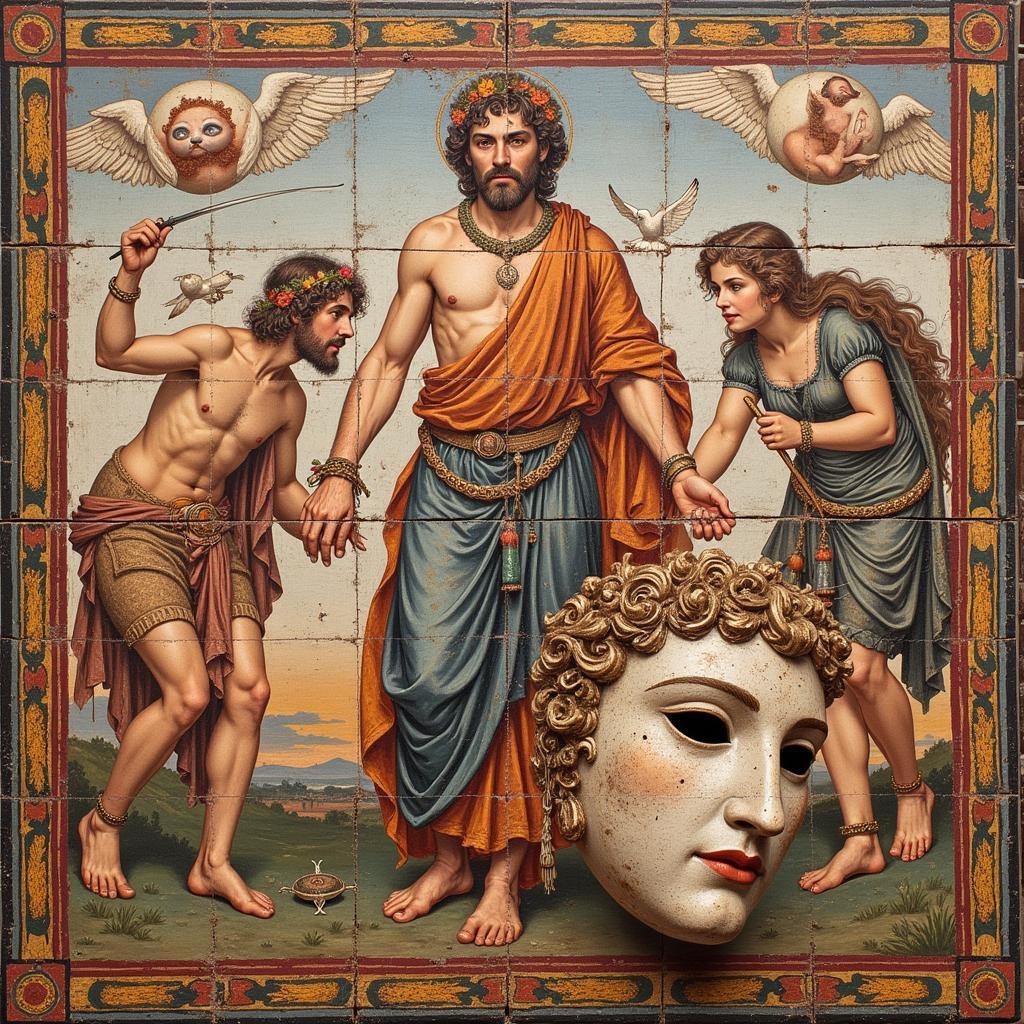Dionysus God Art: Exploring the Ecstasy and Duality
Dionysus God Art captures the intoxicating spirit of the Greek god of wine, theatre, and revelry. From ancient sculptures to modern digital interpretations, Dionysus’s image evokes a sense of duality, oscillating between ecstasy and madness, liberation and chaos. This exploration delves into the fascinating world of Dionysus-inspired art, examining its evolution and enduring influence.
 Ancient Dionysus Sculpture with Grape Vine
Ancient Dionysus Sculpture with Grape Vine
The Many Faces of Dionysus in Art
Dionysus, unlike other Olympian gods, possessed a raw, untamed energy that artists have strived to capture for centuries. His depictions range from the youthful and androgynous to the mature and bearded, reflecting the multifaceted nature of the god himself. Early portrayals often depicted him as a bearded, mature figure, emphasizing his authority over the natural world. Later, Hellenistic art presented a more youthful, effeminate Dionysus, highlighting the sensual and ecstatic aspects of his worship. This shift reflects the evolving understanding of the god and the changing cultural landscape.
 Dionysus Roman Mosaic with Theatre Mask
Dionysus Roman Mosaic with Theatre Mask
From Ancient Greece to the Renaissance and Beyond
The influence of Dionysus extends far beyond ancient Greece. Roman art adopted and adapted the Greek iconography, incorporating him into their own pantheon as Bacchus. During the Renaissance, artists like Michelangelo and Caravaggio reinterpreted Dionysus, drawing inspiration from classical sources while infusing their works with a distinctly modern sensibility. Their paintings often depict the god amidst scenes of revelry, celebrating the pleasures of wine and the intoxicating power of inspiration. Think about how art and alcohol have intertwined throughout history, influencing each other in profound ways. You can learn more about this fascinating connection by exploring our article on art and alcohol.
What are the common symbols associated with Dionysus in art?
Common symbols associated with Dionysus include the thyrsus (a staff tipped with a pine cone), the grapevine, the kantharos (a drinking cup), ivy, and the panther. These symbols represent the god’s connection to nature, wine, ecstasy, and the wild, untamed aspects of human nature. Often, he is depicted surrounded by his followers, the satyrs and maenads, who embody the uninhibited joy and frenzy of his worship.
How has the portrayal of Dionysus evolved over time?
The portrayal of Dionysus has evolved significantly over time, reflecting changing cultural and religious contexts. Early depictions emphasized his authority over nature and fertility, while later representations focused on the ecstatic and liberating aspects of his cult. This evolution demonstrates the fluidity of mythological figures and their adaptability to different cultural interpretations.
Dionysus and the Theatre: A Divine Partnership
Dionysus’s connection to the theatre is another significant aspect reflected in art. He was considered the patron god of Greek theatre, and his festivals were occasions for dramatic performances. Images of Dionysus often incorporate theatrical masks, reminding us of his role in inspiring creativity and performance. This connection underscores the transformative power of art and its ability to transport us to other realms. Looking for inspiring wall art featuring Greek deities? Explore our collection of greek god wall art for stunning pieces that will elevate your space.
What is the significance of the thyrsus in Dionysus god art?
The thyrsus, a staff often tipped with a pinecone and entwined with ivy, is a key symbol of Dionysus. It represents his power over nature, fertility, and the intoxicating effects of wine. In art, the thyrsus serves as a visual identifier of the god and a symbol of his ecstatic cult.
“Dionysus, in his duality, represents the inherent tension within human nature: the desire for order and the pull towards chaos,” notes Dr. Elias Thorne, Professor of Classical Art at the University of Athens. “This tension is what makes him such a compelling subject for artistic exploration.”
Conclusion
Dionysus god art provides a fascinating glimpse into the complex world of Greek mythology and its enduring influence on artistic expression. From ancient sculptures to modern interpretations, the image of Dionysus continues to captivate and inspire, reminding us of the power of art to explore the depths of human experience, including the ecstatic and the untamed. Dionysus’s legacy in art reflects the enduring human fascination with the duality of nature, the allure of the unknown, and the transformative power of creativity.
“The enduring appeal of Dionysus lies in his embodiment of the human desire for liberation and transcendence,” adds Dr. Anya Petrova, art historian specializing in Greek mythology. “His presence in art reminds us of the importance of embracing both the light and shadow within ourselves.”
FAQ
-
Who is Dionysus in Greek mythology?
Dionysus is the Greek god of wine, theatre, and ecstatic revelry. -
What are some common symbols associated with Dionysus?
Common symbols include the thyrsus, grapevine, ivy, and panther. -
How is Dionysus depicted in art?
He is often portrayed as youthful or mature, carrying a thyrsus and surrounded by satyrs and maenads. -
What is the significance of Dionysus in the theatre?
He was the patron god of Greek theatre, and his festivals were occasions for dramatic performances. -
How has the portrayal of Dionysus evolved over time?
His image has shifted from a mature, bearded figure to a more youthful and androgynous one, reflecting evolving cultural perceptions. -
Where can I find more information about Dionysus god art?
Museums, art history books, and online resources offer a wealth of information on this topic. -
What makes Dionysus such a compelling subject for artists?
His duality, embodying both ecstasy and madness, makes him a rich and complex figure for artistic exploration.
For further assistance, please contact us at Phone Number: 02462573573, Email: danteum@gmail.com or visit us at Savico Megamall, 7-9 Đ. Nguyễn Văn Linh, Gia Thụy, Long Biên, Hà Nội 10000, Việt Nam. We have a 24/7 customer service team.


